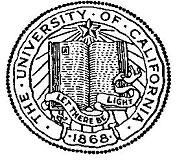
|
IN MEMORIAM
IN MEMORIAM
William Boright Hewitt
Professor of Plant Pathology, Emeritus
Davis
1908—1998
William “Bill” Hewitt was born July 17, 1908 in Fayetteville, Arkansas, to Joseph L. and Beth Boright Hewitt, and died in Sequim, Washington, on July 3, 1998 of heart failure. He married Maybelle E. Ball in August 1934. She died in 1996. They had no children.
The family moved to Lancaster, California, where he graduated from high school in 1928. He attended Santa Ana Junior College and Pasadena Junior College. His life-long association with the University of California at Davis began when he transferred to the University Farm in 1931. He finished his Bachelor of Science degree in pomology (1933), his Master of Science in pomology (1934) and his Doctor of Philosophy in plant pathology (1936). Although these degrees were given by the Berkeley campus, Hewitt proudly proclaimed himself to be a Davis graduate. He was a life member of the California Aggie Alumni Association, serving twice as Treasurer (1946-1950 and 1953-1955) and as president (1958-1959). He helped found the California Aggie Alumni Foundation which he served as secretary (1965-1969) and as a board member (1969-1974).In 1937, Bill joined the Division of Plant Pathology, which became the Department of Plant Pathology at Davis, as junior plant pathologist. He was the fourth academic member of this faculty and was promoted to professor and plant pathologist in 1954. He served the department as chairman (1968-1969). In 1969 he was appointed director of the San Joaquin Valley Agricultural Research and Extension Center, Parlier. He held this position until his retirement in 1974. During his tenure at Davis, he contributed greatly to the strength and international reputation of his department that in 1982 was ranked as the top department of plant pathology in the U.S. by the National Research Council.
Professor Hewitt had an active research program throughout his career. He worked with a spectrum of pathogens - bacteria, fungi, viruses, virus-like agents, and a spectrum of hosts - olives, beans, stone fruits. One is struck by the many specialists with whom he did cooperative research to identify the cause of different problems faced by the growers. His primary interest, however, was in the etiology, epidemiology and control of diseases of the grapevine. His first assignment was to study a lethal grapevine disease that he later named Pierce’s Disease. He showed the cause was a xylem-limited, virus-like agent that also caused alfalfa stunt and was transmitted to and from weed hosts by plant hoppers.
He is known especially for the separation and identification of several viruses in grapevines and is called the father of modern grapevine virology. He was instrumental in establishing the International Council for Study of Viruses and Virus Diseases of Vitis and he served as its president for six years. He was deeply concerned with control of these viruses and recognized the best control program was based on virus-free planting stock. He developed and applied the protocols for detecting virus-infected plants as well as methods for eradicating viruses from these plants by thermotherapy. These virus-free plants were made available to the industry through what is now the Foundation Plant Materials Service. He also directed a similar program by which foreign vines could be imported under federal quarantine, freed of viruses, and released to breeders and viticulturists. These activities attracted numerous visitors as well as providing many opportunities for him to travel and advise on the establishment of similar clean stock programs around the world.
His curiosity about the soil-borne, grapevine viruses led in 1958 to the first identification of nematodes as vectors of plant viruses in work done with colleagues, Professor D.J. Raski and Dr. A. C. Goheen. This research earned them the Ruth Allen Award from the American Phytopathological Society (1974).
Bill served the American Phytopathological Society as councilor (1951-1955), as secretary (1956-1959), as president (1961-1962) and was made a Fellow (1965). He served as a member of numerous committees at the departmental, college and campus level. He was made a member of the Accademi Italiana della Vite e del Vino (1954), was awarded an Alumni Achievement Award from Santa Ana College (1964), was a Fellow of the American Association for the Advancement of Science, and received a special recognition award from the Fresno County Farm Bureau (1973), as well as a Service Award from UCD (1968). In 1991 he was honored with a Distinguished Achievement Award from the California Aggie Alumni Association.
Professor Hewitt taught undergraduate and graduate classes between 1949 (when the department began offering courses and granting degrees) and 1968 when he left for Parlier. He was research advisor for eight doctoral students in these years. Although he generally insisted that his students be sole authors when their thesis research was published, he published over 100 papers on his own research. He served the department as graduate advisor (1960 to 1968). He demonstrated his faith in his department and in graduate education by establishing the W. B. Hewitt scholarship for graduate students in the Department of Plant Pathology upon his death.
Robert N. Campbell
Edward E. Butler
James E. DeVay